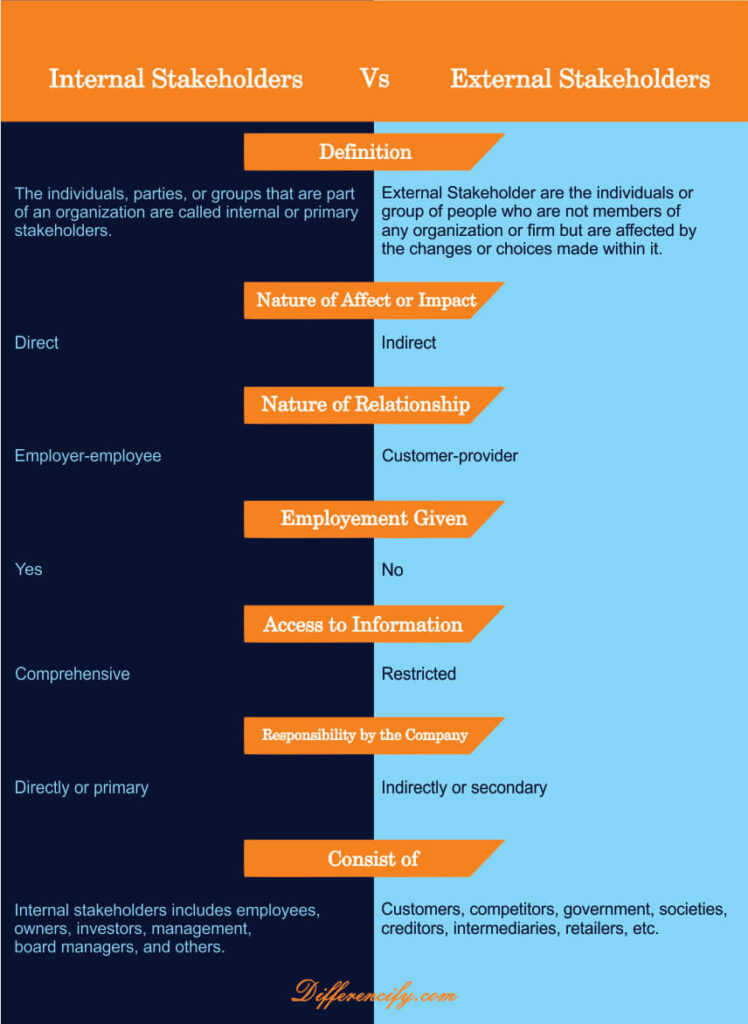Stakeholders play a crucial role in the success of any organization. They are individuals or groups who have an interest or concern in an organization’s objectives, policies, and practices. The concept of stakeholders is central to many fields including management, business, and corporate governance. Stakeholders can be divided into two broad categories – internal and external stakeholders. So, in this article, we will explore the complete difference between internal and external stakeholders with the help of a table and different key points.
Internal Vs External Stakeholders
| Internal Stakeholders | External Stakeholders |
|---|---|
| The individuals, parties, or groups that are part of an organization are called primary or internal stakeholders. | External stakeholders are the individuals or groups of people who are not members of any organization or firm but are affected by the changes or choices made within it. |
| Internal stakeholders have a direct impact on the organization or a business firm. | They have an indirect impact on the business. |
| In the case of internal stakeholders, the nature of the relationship is employer-employee. | In the case of external stakeholders, the nature of the relationship is customer-provider. |
| Employment is given to internal stakeholders. | They are given employment. |
| They have comprehensive access to the company information. | External stakeholders have limited access to the information. |
| The company has a direct or primary responsibility toward them. | The company has indirect responsibility towards external stakeholders. |
| Internal stakeholders have legal rights within the company | External stakeholders have limited legal rights and responsibilities. |
| Examples of internal stakeholders include employees, management, owners, board of directors, shareholders, etc. | Examples of external stakeholders are suppliers, customers, regulators, communities, creditors, clients, intermediaries, competitors, society, government, etc. |
You Can Also Read:
- Difference Between Share and Stock
- Difference Between Merger and Acquisition
- Difference Between Sole Proprietorship and Partnership
Definition Of Internal Stakeholders
Internal stakeholders refer to those individuals, parties, or groups who have direct interest/participation in the management of a company. They can directly affect and can be affected by the profit and loss of the company as they have a vested interest in the organization. The second name for internal stakeholders is primary stakeholders.
Moreover, Stakeholders are highly affected by all the internal activities of the firm like decision-making, profit and loss, performance, and other activities of the company. Without internal stakeholders, an organization would not be able to survive in the long term.
Examples
Some of the examples of internal stakeholders are as follows.
- Employees- Employees refer to the group of people who work for the business entity or company and are directly involved in its day-to-day operations for wages(salary).
- Owners – This implies the individuals who own the company. Examples are partners, shareholders, etc.
- Management – The individuals responsible for leading and making decisions for the organization.
- Board Of Directories- Board of directories refers to the group of people who governs the incorporated organization. They are elected at AGM(Annual General Meeting) by the members of the company.
- Investors- Investors refer to individuals or a group who invest their money in the company.
- Departments – Different units within the organization that have specific functions and responsibilities.
- Shareholders – Owners of the organization who have a financial stake in its performance.
- Managers- These are groups of individuals who manage the entire department. For Example, General manager, sale manager, etc.
Definition Of External Stakeholders
External stakeholders or secondary stakeholders refer to those interested groups, individuals, or parties who have indirect interests in an organization. Though they are not part of the entity, they can indirectly affect or can be affected by the changes or activities of the company. They are aware of publicly available data/information of the entity.
External stakeholders externally manage the company. They do not engage with day to day actions of the firm and have no idea about the internal affairs of the company. In fact, the actions of the company influence them. External stakeholders of the company are suppliers, customers, creditors, rival companies, retailers, intermediaries, and others.
Examples
The five examples of external stakeholders are as follows.
- Customers: Individuals or organizations who purchase goods or services from the organization.
- Suppliers: Organizations or individuals who provide goods or services to the organization.
- Competitors: Other organizations that offer similar goods or services in the same market.
- Government: The government at various levels (local, state, national) that may regulate the organization’s operations and activities.
- Community: The local residents and organizations that are impacted by the organization’s activities, such as the local economy, environment, and quality of life.
Key Differences Between Internal And Stakeholders
Some of the key differences between internal and external stakeholders are.
- Meaning: Internal stakeholders refer to those individuals, parties, or groups who have a direct interest or participation in the management of a company. On the other hand, External stakeholders or secondary stakeholders refer to those interested groups, individuals, or parties who have indirect interests in an organization.
- Relationship with Business: Internal stakeholders internally serve the organization. On the other hand, external stakeholders deal with the organization externally.
- Involvement in Decision-Making: Internal stakeholders are directly involved in decision-making processes, while external stakeholders have no direct involvement.
- Interests: Internal stakeholders have a vested interest in the success and growth of the organization, while external stakeholders are mainly concerned with the external impact of the organization.
- Level of Influence: Internal stakeholders have more influence over the organization’s decision-making process than external stakeholders.
- Timeframe: Internal stakeholders have a longer-term interest in the organization, while external stakeholders are usually concerned with short-term impact.
- Relationship with the Organization: Internal stakeholders have a direct relationship with the organization, while external stakeholders have an indirect relationship.
- Examples: While internal stakeholders include employees, creditors, the board of directors, owners, etc. On the other hand, external stakeholders include suppliers, retailers, creditors, customers, rival companies, society, etc.
The following table also compares both internal vs external stakeholders.

You Can Also Read:
Internal and External Stakeholders in Project Management
Internal stakeholders are members or groups within an organization who are impacted by a project and have a vested interest in its outcome. They have direct involvement and access to the project’s decision-making process. Examples include project team members, department managers, and executive leadership. They may be responsible for providing resources, making decisions, and ensuring the project aligns with the organization’s goals.
External stakeholders are individuals or organizations outside of the company that is impacted by or have an interest in the project’s outcome. They do not have direct control over the project but their involvement and support are important for its success. Examples include customers, suppliers, regulatory agencies, and community organizations. They may be affected by the project’s outcomes and may have expectations for the project’s deliverables and results. Effective communication and engagement with external stakeholders are crucial for ensuring their support and cooperation throughout the project.
Internal and External Stakeholders in Healthcare
Internal stakeholders in healthcare refer to individuals and groups within a healthcare organization, such as employees, physicians, nurses, administrators, and boards. These stakeholders have direct involvement in the operations and decision-making of the healthcare organization.
External stakeholders in healthcare refer to individuals and groups outside the healthcare organization that have an interest in or impact on its operations. These may include patients, families, regulatory agencies, payers, suppliers, and the community. These stakeholders can influence or be affected by the policies and practices of the healthcare organization.
Conclusion
In conclusion, understanding the difference between internal and external stakeholders is important for organizations to make informed decisions and to ensure the success and growth of the organization. Both internal and external stakeholders play a crucial role in the success of any organization, and it is important for organizations to engage with both groups in an effective and meaningful way. Organizations should work to balance the interests and concerns of both internal and external stakeholders to ensure the best outcomes for all parties.
You Can Also Learn More:



One Comment